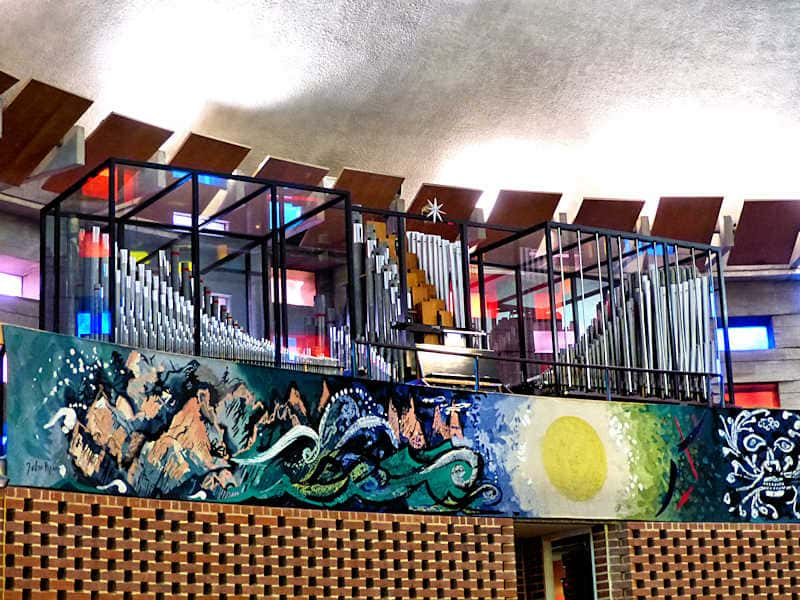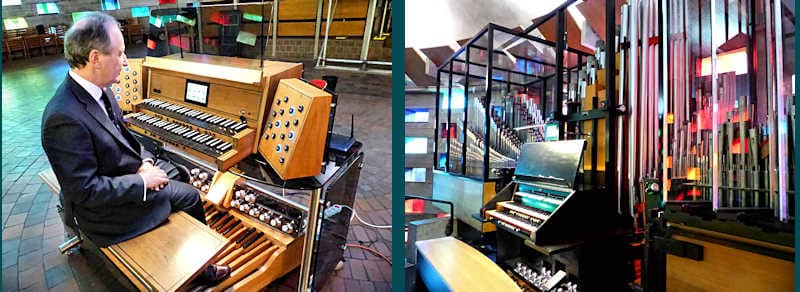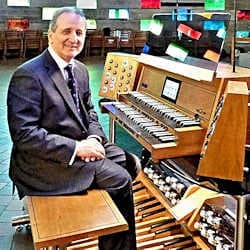It’s rare for an organ from the 1960s to merit a scrupulous restoration, but Grant, Degens & Bradbeer’s striking 1966 instrument — totally enclosed in glass — in The Meeting House at the University of Sussex is one such example.
It is hard now to imagine the post-war eagerness for progressive organ design. This was at its most vigorous in Germany, as the country rebuilt its churches following WWII, and in Scandinavia. Maurice Forsyth-Grant was inspired by what he saw in these countries and determined to start his own organ-building company to make similar instruments for the UK. He was fortunate in four regards: (1) John Compton & Co had just sold out to Rushworth & Dreaper, leaving several of their highly-skilled staff looking for work in the London area, (2) premises in London were plentiful and (at the time) inexpensive, (3) there was an appetite among musicians for updating or scrapping Victorian organs in favour of ‘neo-baroque’ tonal schemes, and (4) Grant had sufficient funds to bank-roll a company which in the end never made a profit. From Comptons, Grant took Edward Rippin and John Degens into partnership. The firm was ‘Degens & Rippin’, then ‘Grant, Degens and Rippin’, finally ‘Grant, Degens & Bradbeer’, after the advent of architect Frank Bradbeer and the departure of Ted Rippin. The Sussex organ bridged the gap between GDR and GDB.

Everything about the Sussex organ was modern — its glass-encased visual design, its advanced tonal scheme and ‘open-foot’ voicing, its Schwimmer-based wind system and chipboard soundboards, and its console — finished in black lacquer. Chichester Cathedral organist, John Birch, served as University Organist from 1967 and the organ was much heard. Following Dr Birch’s departure in 1994 the organ began to fall on hard times, its actions and electrical components becoming unreliable and its voicing and tuning falling out of regulation, despite some modest overhaul work some years before. Its future rather hung in the balance when I was asked in 2013 to write a report. You may be interested to read that Report & Recommendations [4.3mb — opens new tab] (a typical example of my regular work), which is detailed and has many interesting photos.

In order to encourage the University to be interested in — and proud of — their Meeting House organ again, I proposed a complete restoration and the fitting of a second, mobile console of provocatively contemporary design, connected wirelessly to the organ. This was — to my relief — taken up by the University with enthusiasm, and Clevedon Organs were contracted to do the work. Everything in the organ was restored, the voicing carefully re-set, new electrics fitted throughout, and the mobile console made by Renatus of Bideford. Such has been the success of the project that the University soon appointed its first University Organist since John Birch, a player whose flair, style, and appreciation of all this organ says is perfect for the post — D’Arcy Trinkwon.
I’m particularly proud of this project — having already an affinity with GDB organs from my time as organ scholar at New College, Oxford — and I hope that the Meeting House Organ will long stimulate all from the University and area who hear it.
Links
- return to Projects of significance page
